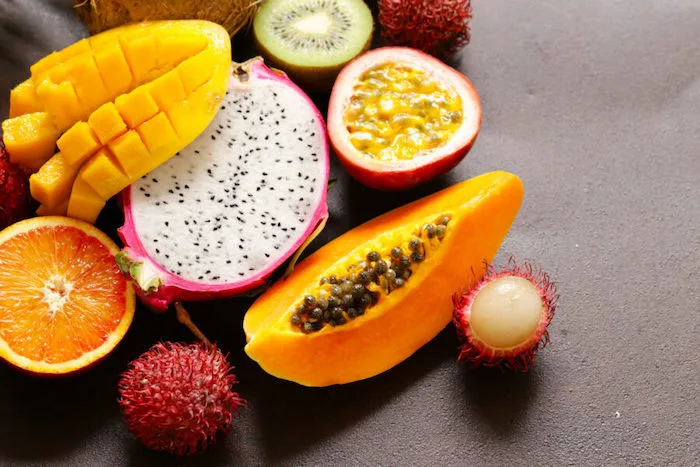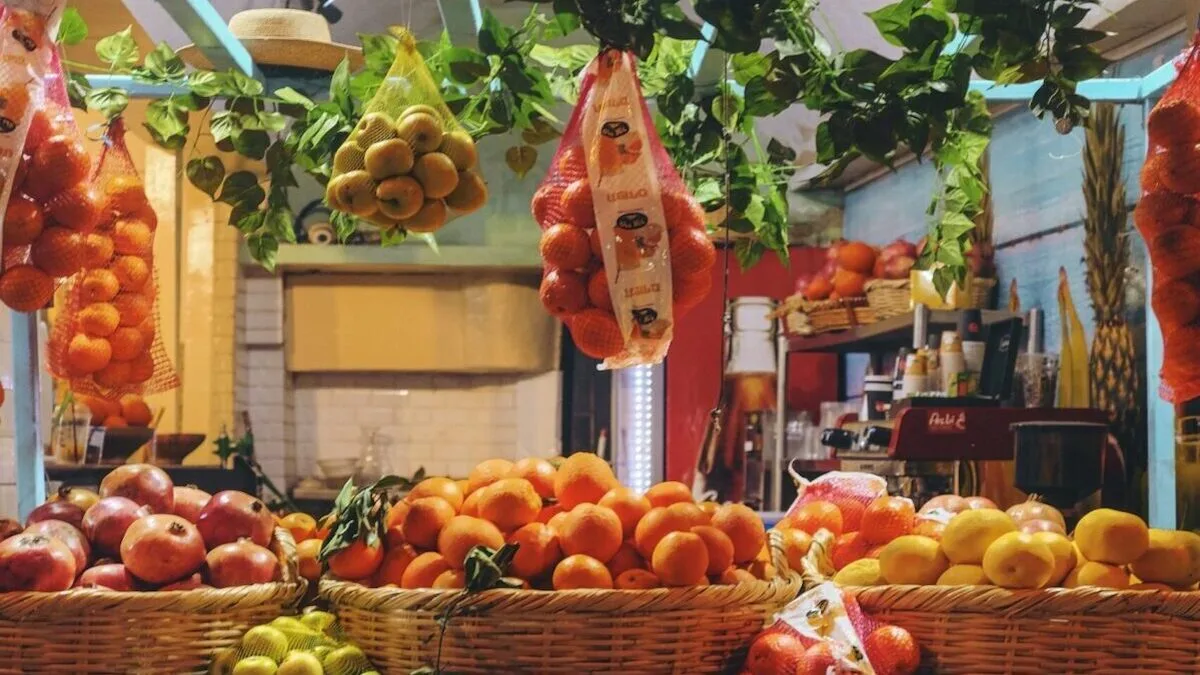Table of contents
Best Tropical Fruits to Grow
The best tropical fruits to grow are worth close consideration. These often delicious fruits come in a range of shapes, sizes and flavours. Indeed the number and variety of fruits that originate in the tropics is amazing.
When you add these to fruits from other climate zones that also grow well in the tropics, choice abounds.

Tropical Fruits to Grow in Australia
You can grow many different tropical fruits in Australia. This is a list of our favourites:
- Black Sapote
- Custard Apple
- Dragon Fruit
- Grumichama
- Guava Tree
- Jaboticaba
- Kumquat Tree
- Lemonade
- Mamey Sapote
- Mulberries
- Natal Plum
- Passion Fruit
- Paw paw
- Rambutan
- Star Apple
- Watermelon
When considering what tropical fruits to grow, don’t let the fact some of these trees can grow very large put you off. The backyard gardener simply has to prune to keep those monsters under control.
Indeed, when grown commercially, most of these trees, as well as some not on our list, including the lychee and mango, are pruned regularly as a matter of course.
Tropical Fruits That Grow on Trees
Many of the non tropical fruits grown in the tropics are citrus. We are fans of the lemonade fruit in particular. However, there are many other citrus that will also grow and thrive in the tropics. We love them as they are fast growing and produce abundantly. Below are some of our citrus champions.
- Fingerlime
- Grapefruit
- Lemonade
- Lemons (The Meyer Lemon in particular thrives in the tropics)
- Mandarin
- Oranges
- Tangerine
Of course some citrus actually originate from the tropics! One of these is the West Indian lime, known as the key lime. The grapefruit is another. However, my favourite tropical citrus is the pummelo (aka pomelo).
The pomelo is related to grapefruit, but is sweeter. There are several types of pomelo, including Nam Roi, which produces a large sweet seedless fruit.
The blood orange is another favourite of ours. It is attractive, hardy and loves the heat. Consequently, we love growing blood orange.
Non Tropical Fruit to Grow
Why not start growing mulberries?
Unlike mulberries grown in southern climate, mulberries grown in the tropics will grow into a bush, not a tree. However the fruit is just as sweet.
Tropical Fruit Trees Australia
Before finishing, we should mention some of the ‘iconic’ tropical fruits to grow (that do not appear above), but are an important part of life in the tropics. That is, the lychee, bananas, pineapple, mangosteen and of course, the coconut!
Lychee fruit is the most obvious thing missing from the above list. We love to eat them, we just don’t grow them. Lychee trees are one of the larger trees and we just don’t have room for one in our yard. However, if you do – go for it! The lychee is one of the sweetest tropical fruits to grow in the tropics. Eating lychees is a natural part of life in Far North Queensland.
Bananas are another fruit you can grow very easily. However, we are just not banana lovers. Fortunately there is a lot of information already out there on how to grow bananas.
Pineapple’s are iconic in Queensland and they do grow in the topics. However they take more than 12 months to grow (and we are just not that patient).
The coconut is one of the most popular tropical fruits to grow. It is important to the diet, landscape and culture of many tropical areas. It is easy to grow, provides food and milk and is much loved, especially in the pacific.
The mangosteen is another popular tropical fruit. Don’t let the name confuse you, it is nothing like a mango. The fruit has a white flesh with a ‘sweet and tangy’ taste. A tropical evergreen tree, the mangosteen is widely grown in Southeast Asia.
Fruits and vegetables that grow on vines
Of course not all fruits grow on tropical fruit trees. Indeed there are a number of fruits that grow on tropical vines. Passionfruit is a great example.
The monstera or Swiss cheese plant (Monstera deliciosa) is another popular vine. It requires rich, well-drained soil and a shaded spot and can grow to 30 feet. Monstera flowers are a long, white, spike that grows at ground level. The spike is surrounded by a boat-shaped spathe.
Kiwi vines (Actinidia deliciosa) are also grown in the tropics. Plant kiwi vines in well-drained soil and a sunny spot. Provide a support structure such as a trellis and cut back the branches that produce fruit to encourage fresh growth.
Tropical Fruits to Grow in Pots
Tropical fruits easily grown in pots includes most dwarf citrus, but the most obvious tropical fruit that grows easily in pots in Queensland is the pineapple!
Tropical Fruits to Grow Indoors
Growing tropical fruits indoors is a fun and rewarding way to enjoy exotic flavors at home. Some tropical fruit plants are particularly well-suited for indoor environments as they are compact and adaptable to containers. Here are some great options:
- Pineapple
Growing Method: Start from a store-bought pineapple top or from baby plants.
Care: Pineapple plants require bright light and minimal water. They tolerate low humidity, making them fairly easy to grow indoors.
Harvest Time: Takes about 2–3 years for indoor plants to produce fruit. - Meyer Lemon Tree
Care: Thrives in bright, direct sunlight and well-drained soil. Regular watering is necessary, but they don’t like soggy soil.
Size: Can reach 4–6 feet indoors with pruning.
Bonus: Fragrant flowers and year-round potential for fruit. - Coffee Plant
Care: Thrives in bright, indirect light and requires high humidity, making it a good fit for bathrooms or kitchens.
Bonus: In addition to fruit, it offers fragrant white flowers.
By providing adequate light, warmth, and humidity, these tropical plants can thrive indoors, producing delicious fruit with the added charm of lush greenery.
Growing Jackfruit
One of the less well known tropical fruits to grow is the jackfruit. Growing jackfruit (Artocarpus heterophyllus), the largest tree-borne fruit, can be a rewarding endeavor, especially in warm climates.
Jackfruit trees thrive in tropical or subtropical climates. They need consistent warmth, ideally between 77-95°F (25-35°C), and don’t tolerate frost.
USDA Hardiness Zones: Best suited to zones 10-12.
Jackfruit trees require full sun (6-8 hours daily) to grow well and produce fruit.
Soil: They prefer loamy, well-drained soil with a slightly acidic to neutral pH (5.5-7.5). Jackfruit is sensitive to waterlogged soil, so ensure good drainage.
Jackfruit is typically grown from seeds, which should be planted fresh for higher success rates. Plant seeds directly into the soil about 1 inch deep, and germination usually occurs within 3-8 weeks.
For quicker fruit production, choose a grafted sapling. Grafted trees can begin to bear fruit in as little as 3-4 years compared to 8-10 years for seed-grown trees.
Jackfruits take 3-8 months to mature after flowering. Harvest when the fruit changes color slightly and emits a strong fragrance. Use a sharp knife to cut it from the tree, as the fruit and sap can be sticky.
With the right climate, care, and patience, jackfruit trees can thrive and provide large, flavourful fruits ideal for fresh eating or cooking.
Don’t Even Try Southern Specialists
In these days of artificial micro-climates and genetic modification it seems almost anything is possible. However, it remains easier to work with the environment than to try to modify it. Consequently, some of the non tropical fruits we would not even try to grow in the tropics include apples, pears, peaches, cherries and other temperate specialists.

